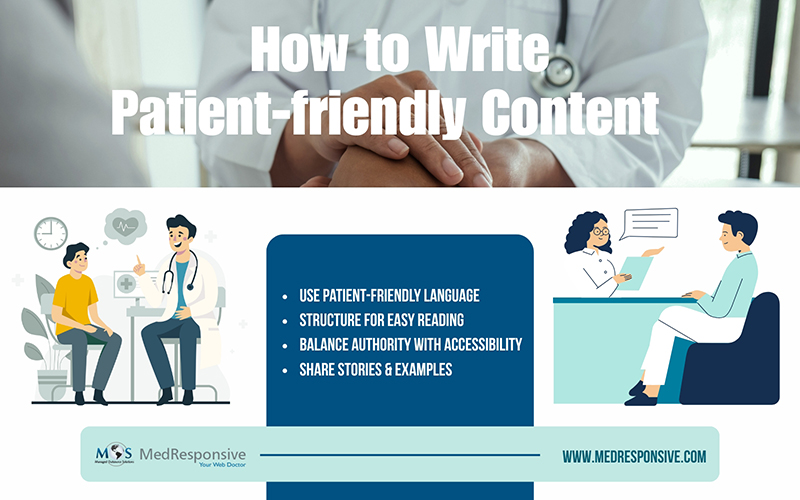77% of people look for healthcare-related information online before booking a healthcare appointment.
And, if you think they’re just looking for nearby hospitals or clinic details, you’re wrong. They’re browsing symptoms, treatment guides, patient testimonials, and even comparing physicians before deciding.
This means your website isn’t just a digital brochure, it’s the first point of trust for people making critical health decisions. But here’s the challenge: how do you write content that speaks both to anxious, information-seeking patients and to the algorithms deciding whether your website even shows up in their search results?
That’s where a smart content strategy for healthcare websites comes in: one that balances empathy with SEO, clarity with optimization, and medical authority with accessibility.
Let’s dive into how you can build a content strategy that keeps both your patients and search engines happy.
Why Content Strategy Matters More in Healthcare
The healthcare industry is one the most competitive in the world, and considering the ongoing transformation with respect to AI and automation, the battle for search visibility between hospitals, doctors, and even telehealth providers is fierce.
Unlike e-commerce or lifestyle niches, healthcare is deeply personal. When someone Googles “persistent chest pain” or “best dental surgeon near me,” they’re not just browsing casually; they’re searching because they are worried, vulnerable, and looking for immediate answers.
A weak or generic content strategy can:
- Turn patients away if your content feels rigid or unclear.
- Damage reputation if your information is outdated or inaccurate.
- Leave you from the top search results if you ignore SEO basics.
On the flip side, a strong strategy can:
- Educate and reassure patients.
- Showcase your expertise and build credibility.
- Improve local visibility, helping patients find your practice right when they need it most.
healthcare content strategy isn’t optional, it’s a mandatory action.
Writing for Patients: Clarity, Trust, and Empathy
Patients don’t want to feel like they’re reading a research paper. They want patient-focused content they can understand, and that too, fast. Therefore, your content should prioritize empathy.
Here are some key tips:
- Use Patient-friendly Language
Stay away from medical jargon (attempting to convey your medical expertise), unless you explain it. For example:
- “Hypertension is characterized by elevated systolic and diastolic blood pressure.” This is not patient-friendly, and it could discourage the reader from reading beyond. Instead, write: “High blood pressure (also called hypertension) happens when the force of your blood against your artery walls is too high.”
- Structure for Easy Reading
- Categorize content into short paragraphs.
- Use headings and bullet points.
- Add FAQs for quick answers.
Remember: patients often skim, especially when anxious/overwhelmed.
- Balance Authority with Accessibility
Patients are looking for reassurance and that means your content should be trustworthy. Back up your claims with credible sources, but don’t overcomplicate things. A line like “According to the American Heart Association…” adds authority without overwhelming the reader.
- Narrate Stories and Use Real-life Examples
Nothing connects better than stories. For instance, sharing how a patient recovered from knee surgery (with their consent, anonymized if necessary) makes your content relatable.
Writing for Search Engines: SEO with a Human Touch
Now, let’s take a look at the other side. While your patients are your audience, Google is the gatekeeper. Therefore, if your website isn’t optimized, patients won’t even see it.
Here’s how to satisfy search engines without losing the human element:
- Keyword Research with Intent in Mind
Patients don’t just search “cardiologist.” They search things like:
- “Best cardiologist near me”
- “When to see a doctor for chest pain”
- “Heart healthy diet for high blood pressure”
Mix short-tail (broad) and long-tail (specific) keywords in your content. This way, you capture both general interest and urgent, intent-driven queries.
- Optimize Local SEO
For healthcare, local visibility is everything. Make sure your content includes:
- Your city or region (e.g. “Pediatric Dentist in NYC”).
- Localized landing pages.
- Google Business Profile integration.
- Prioritize E-E-A-T (Experience, Expertise, Authority, Trustworthiness)
Google pays extra attention to Your Money or Your Life (YMYL) content, which includes healthcare. That means:
- Have expert authors or doctors review your content.
- Keep articles updated with the latest medical information.
- Showcase credentials and certifications.
- Use Structured Data & FAQs
Adding schema markup (like FAQ schema) helps with medical website optimization, so your content appears in featured snippets and “People Also Ask” boxes. This improves visibility and credibility.
Finding the Sweet Spot: Writing for Both Patients & Search Engines
How to write healthcare content for patients and search engines? Here’s the secret: it’s not patients OR search engines. It’s patients THROUGH search engines.
What does that mean?
- Write naturally but incorporate keywords where they fit.
- Answer real patient questions but optimize headings for SEO.
- Use meta descriptions that not only include keywords but also entice clicks.
For example:
“Wondering if your back pain needs medical attention? Learn about the common causes, when to see a doctor, and available treatments. Trusted information from [Practice Name].”
This snippet is keyword-optimized, informative, and patient-focused so make sure the SEO elements are optimized to enhance your rankings.
Content Types That Work Best for Healthcare
Not all content is created equal. Some formats perform especially well for healthcare websites:
- Educational Blogs & Articles: Great for SEO and answering patient queries.
- FAQs & Resource Centers: Quick answers to common patient concerns.
- Videos & Infographics: Translate complex medical information into visuals.
- Doctor/Practice Profiles: Builds trust by showcasing expertise and credentials.
- Service Pages: Clear, detailed, and locally optimized explanations of services.
- Testimonials & Case Studies: Humanize your brand and boost credibility.
How Often Should You Publish?
Consistency is key more than ballooning up numbers for the sake of it. A blog posted once every 2–3 weeks with quality, optimized content is far better than spamming your followers’ feeds with 10 generic posts at once.
Also, make sure to update old blogs with fresh and relevant information that will help maintain rankings and credibility.
What Are the Mistakes to Avoid in Healthcare Content Strategy?
- Writing only for Google, ignoring patient readability.
- Publishing medical info without citing credible sources.
- Using walls of text without headings or breaks.
- Neglecting local search optimization services.
- Treating your website as a one-time project instead of an evolving resource.
Why Collaborate with MedResponsive for Healthcare Content Strategy?
At MedResponsive, we get that healthcare content isn’t just about clicks—it’s about trust, empathy, and visibility. We help healthcare providers craft strategies that resonate with patients and perform well on search engines.
Here’s why clients love working with us:
- We specialize in digital marketing and healthcare SEO services.
- We create patient-centered content reviewed for accuracy.
- We optimize for local visibility, ensuring the right people find you.
- We balance technical SEO with engaging storytelling.
Final Thoughts
In today’s digital-everything world, your healthcare website should efficiently carry out two tasks: reassure and guide patients, and signal credibility and authority to search engines. A content strategy that balances both ensures you’re not just visible; but trusted as well.
And remember, this isn’t something you need to figure out alone. With MedResponsive, you get a partner who understands the unique challenges of healthcare marketing and knows how to turn your website into a patient magnet.





